Please use this identifier to cite or link to this item:
https://has.hcu.ac.th/jspui/handle/123456789/512| Title: | การวิเคราะห์เชิงเปรียบเทียบเพลงกล่อมเด็กของไทยกับจีน |
| Other Titles: | A Comparative Analysis of Thai and Chinese Lullabies 泰国与中国摇篮曲的研究对比 |
| Authors: | ธิดา โมสิกรัตน์ Thida Mosikarat Chai, Yao Huachiew Chalermprakiet University. Faculty of Liberal Arts |
| Keywords: | เพลงกล่อมเด็ก -- ไทย เพลงกล่อมเด็ก -- จีน Lullabies, Nursery rhymes -- Thailand Lullabies, Nursery rhymes -- China การวิเคราะห์เนื้อหา Content analysis (Communication) 催眠曲 -- 中国 催眠曲 -- 泰国 内容分析 |
| Issue Date: | 2013 |
| Publisher: | มหาวิทยาลัยหัวเฉียวเฉลิมพระเกียรติ |
| Abstract: | การวิจัยเรื่องนี้มีวัตถุประสงค์เพื่อศึกษาและเปรียบเทียบเนื้อหาเพลงกล่อมเด็กของไทยกับจีน และเพื่อศึกษาและเปรียบเทียบการใช้ภาษาในเพลงกล่อมเด็กของไทยกับจีน โดยคัดเลือกแบบเจาะจงเป็นเพลงที่พิมพ์เผยแพร่และมีเนื้อเพลงคล้ายคลึงกัน ชาติละ 21 เพลง รวม 42 เพลง และใช้วิธีคัดเลือกเพลงกล่อมเด็กไทยที่เด็กชอบ ด้วยการสอบถามนักเรียนชั้นประถมศึกษาปีที่ 2-5 โรงเรียนถนอมพิศ กรุงเทพมหานคร และคัดเลือกเพลงกล่อมเด็กจีนเฉพาะของประเทศสาธารณรัฐประชาชนจีน ซึ่งผู้วิจัยแปลเป็นภาษาไทยและตรวจสอบโดยการสอบถามนักศึกษาไทยที่เรียนหลักสูตรภาษาจีน ชั้นปีที่ 4 มหาวิทยาลัยศิลปากร นำเสนอผลการวิจัยด้วยวิธีพรรณนาวิเคราะห์ ผลการศึกษาพบว่า เนื้อหาของเพลงกล่อมเด็กไทยและจีน แบ่งเป็น 1) เพลงที่มีเนื้อหาเกี่ยวกับธรรมชาติ เพลงกล่อมเด็กของไทยและจีนสะท้อนภาพชนบทที่เป็นสังคมเกษตรกรรมเพลงของไทยมีเนื้อหาสัมพันธ์กับวัฒนธรรมและความเชื่อของคนไทย เพลงกล่อมเด็กของจีนเป็นเรื่องของวิธีการกล่อมเด็กของคนจีน 3) เพลงที่มีเนื้อหาเกี่ยวกับความรัก เพลงกล่อมเด็กของไทยและจีนสะท้อนให้เห็นความรักของแม่ที่มีต่อลูก เพลงกล่อมเด็กของไทยสะท้อนความห่วงใยของแม่ ส่วนเพลงกล่อมเด็กของจีนกล่าวถึงความรักต่อลูกและความรักที่มีต่อคนอื่นด้วย 4) เพลงที่มีเนื้อหาเกี่ยวกับนิทานและวรรณกรรมเพลงกล่อมเด็กของไทยกับจีน แต่งตามเรื่องวรรณกรรมที่มีชื่อเสียง เพลงกล่อมเด็กของไทยเลือกเนื้อเรื่องบางตอนหรือตัวละครบางตัวมาแต่ง ส่วนเพลงกล่อมเด็กของจีนนิยมย่อเรื่องนิทานแล้วปรับแต่งเป็นเนื้อเพลง ในด้านการใช้ภาษาในเพลงกล่อมเด็กไทยกับจีน ผลการวิจัยพบว่า มีลักษณะคล้ายคลึงกันในการใช้คำทอดเสียง คำซ้ำ คำสามัญ คำศัพท์ และโวหารประเภทบรรยายโวหาร พรรณนาโวหาร อุปมาโวหาร และบุคลาธิษฐาน ลักษณะแตกต่างกัน คือ การใช้คำสัมผัส ในเพลงกล่อมเด็กของไทย ไม่บังคับ แต่ของจีนบังคับเป็นคำสุดท้ายของแต่ละวรรค การใช้ภาษาที่ปรากฏเฉพาะในเพลงกล่อมเด็กของไทย คือ คำขึ้นต้นและโวหารอติพจน์ This research aims to analyze comparatively the content and language usage of Thai and Chinese lullabied. The scope of the study includes forty-two selected Thai and Chinese lullabies, twenty-one of each. The selection focuses on Thai and Chinese lullabies which contents or stories are similar and have been published for sales. The Thai lullabies are chosen by students, Grade 2 to 5 from Thanompist School, Bangkok. The Chinese lullabies are chosen by the researcher, from two books of collected Chinese lullabies. The research finds that contents of the studied lullabies reflect their cultural and social contexts, which are: 1) lullabies relating to animals usually include the mother's role, most found in THai lullabies, and refer to calm surroundings to convince young children to sleep, in Chinese lullabies, 2) lullabies relating to the nature always describe the life of folk people in rural farming society, in particular Thai lullabies likely refer to some traditions and beliefs, while Chinese lullabies focus on making the children sleepy, 3) lullabies relating to the mother's love often describe the mother's care for her children, especially Thai lullabies, while Chinese lullabies also include the love for others, and 4)lullabies relating to tales or well-known stories usually refer to a part or a character in outstanding literary works, most found in Thai lullabies, while Chinese lullabies present the summary of the whole story in shot lyrics. Relating to the language usuage of the studied lullabies, the similarities found are the use of unstressed sound at the end, the repetition of words, the use of common words and vocabulary, the narration in descriptive and narrative styles, and the use of figure of speech - such as personification. The differences of Thai and Chinese lullabies found in this research are the use of rhyme which Thai lullabies are alternative, while Chinese lullabies strictly use the end ehyme. The particular language usage found only in Thai lullabied is the use of introductory words at the beginning and the use of hyperbole. |
| Description: | วิทยานิพนธ์ (ศศ.ม.) (การสื่อสารภาษาไทยเป็นภาษาที่สอง) -- มหาวิทยาลัยหัวเฉียวเฉลิมพระเกียรติ, 2556 |
| URI: | https://has.hcu.ac.th/jspui/handle/123456789/512 |
| Appears in Collections: | Liberal Arts - Theses |
Files in This Item:
| File | Description | Size | Format | |
|---|---|---|---|---|
| Abstract.pdf Restricted Access | 195.94 kB | Adobe PDF | View/Open Request a copy | |
| Tableofcontents.pdf Restricted Access | 100.46 kB | Adobe PDF | View/Open Request a copy | |
| Chapter1.pdf Restricted Access | 192.57 kB | Adobe PDF | View/Open Request a copy | |
| Chapter2.pdf Restricted Access | 225.59 kB | Adobe PDF | View/Open Request a copy | |
| Chapter3.pdf Restricted Access | 370.18 kB | Adobe PDF | View/Open Request a copy | |
| Chapter4.pdf Restricted Access | 553.92 kB | Adobe PDF | View/Open Request a copy | |
| Chapter5.pdf Restricted Access | 129.4 kB | Adobe PDF | View/Open Request a copy | |
| References.pdf Restricted Access | 215.56 kB | Adobe PDF | View/Open Request a copy |
Items in DSpace are protected by copyright, with all rights reserved, unless otherwise indicated.
